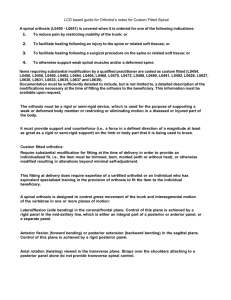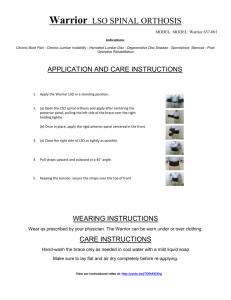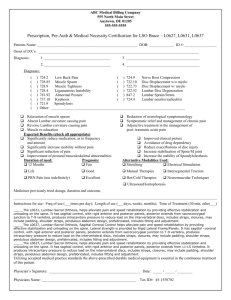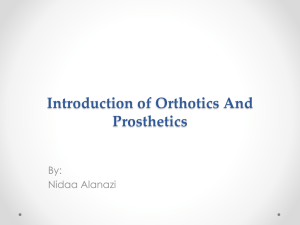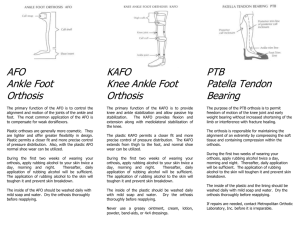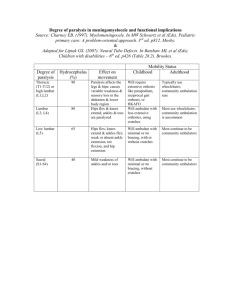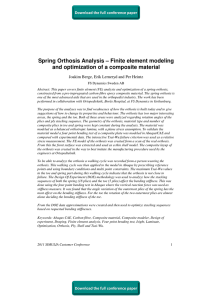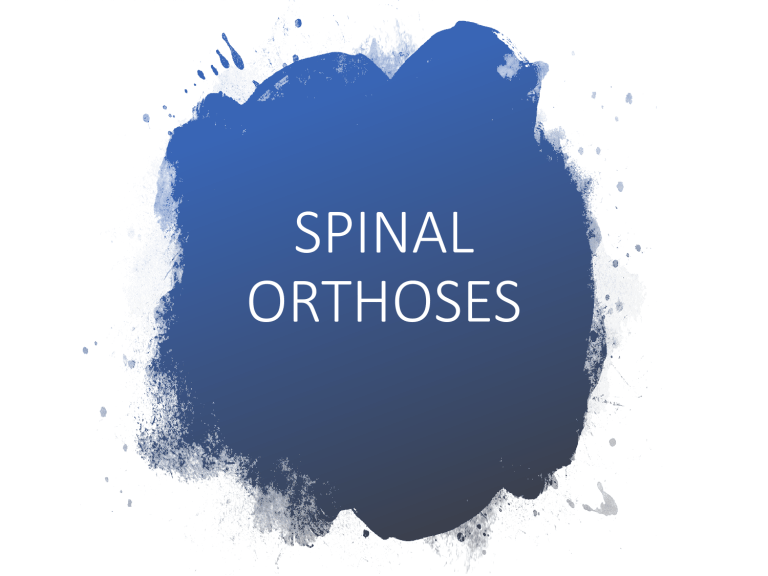
SPINAL ORTHOSES Purpose of Spinal Orthoses • Prevention and Correction of Deformities • By providing external forces • Applying corrective forces to abnormal curvatures • 3-point pressure system • Reduction of Axial Loading • Elevated intra-abdominal pressure • Reduces the net force applied to spine during the act of lifting a weight from the floor • Reduces intradiscal pressure approximately 30% in lumbar spine • Postsurgical Stabilization • With or without fracture Objective of Spinal Orthoses • Control of Pain • limiting motion or weight bearing • Provides heat to an area • Protection against further injury • Limits motion • Stabilization of vertebral segment • Provides stabilization when soft tissue cannot • Assistance for muscle weakness • Serves as a kinesthetic reminder Ideal Orthosis • Functional • Fits well • Light in weight • Easy to use • Cosmetically acceptable • Easily maintained/repaired • Ideally locally manufactured Prescription Spinal Orthotics • Diagnosis/Indications • Goals of the orthotic device • Area to be covered • Control desired • Based upon biomechanics of the spine • Restriction of sagittal plane motion • Restriction of coronal plane motion • Restriction of transverse plane motion • Flexible Device vs Rigid • Custom vs Off-the-shelf Custom vs Off-the-shelf • Tenet of Orthotic classical practice • More intimate fit with custom • Better control of Triplanar Motion with custom • Better control of lateral flexion and Rotation with custom • Unequal panels from OTS that creates flexion or extension components • Rotation not controlled in OTS due to not locking down on ASIS or the rib cage • Custom better adjustment for pendulous abdomen • Custom more comfortable to wear than OTS Duration of use of spinal orthosis Pain: 1-2 weeks Instability: till the patient can tolerate discomfort. Post surgical: after acute fractures 6-12 weeks Gradual removal + static EX Complications of spinal orthosis Discomfort & local pain Osteopenia Skin breakdown Nerve compression Muscle atrophy with prolonged use Decreased pulmonary capacity Increased energy expenditure with ambulation Difficulty donning and doffing orthosis Difficulty with transfers Psychological and physical dependency Increased segmental motion at ends of the orthosis Unsightly appearance Poor patient compliance Success of spinal orthosis Decreased pain Increased strength Improved function Increased proprioception Improved posture Correction of spinal curve deformity Protection against spinal instability Minimized complications Healing of ligaments and bones Nomenclature/Categories • Name by the body regions that they cross • CO: Cervical Orthosis • Soft or rigid (Philadelphia, Aspen, Miami, Newport) • CTO: Cervicothoracic orthosis • Halo, SOMI, Minerva • CTLSO: Cervicothoracolumbosacral orthosis • Milwaukee • TLSO: Thoracolumbosacral orthosis • Custom-molded body jacket, CASH, Jewett • LSO: Lumbosacral orthosis • Chairback, Knight, corsets/binders • SO: Sacral orthosis • Trochanteric belt, sacral belt, sacral corset BACKGROUND SPINE BIOMECHANICS Range of Motion Spinal Area Braddom 3rd edition Three Point Pressure system • 3-point pressure system • Supplies anterior abdominal pressure • Increase intracavity pressure • Decrease lumbar lordosis • Decrease load on the vertebra and disc • Restricts trunk and intervertebral motion • Control of motion categories • Flexion • Flexion-extension • Flexion-extension-lateral bending • Flexion-extension-lateral bending-rotation • Supports/aligns spine • Most restricted motion cephalad region • Least control at L/S junction FLEXIBLE SPINAL ORTHOSES Sacroiliac Belt Sacroiliac Belt • Width: 2 – 4 inches • Borders • Superior: Iliac crest • Inferior: Greater trochanter • Function: Sacroiliac joint stabilization • Indications: Postpartum and posttraumatic sacroiliac operations • Accessory (Optional): • Perineal Straps • Function: Prevention of upward displacement. Sacroiliac Corset Sacroiliac Corset Material: Cloth • (+) adjustable circumference via lateral, anterior, or posterior laces/hooks. Borders • Superior: Iliac crest • Inferior - Anterior: ½ – 1 inch above the pubic symphysis - Posterior: Gluteal bulge (apex) • Provides assistance to pelvis only • The main indication is hyper mobility of sacroiliac joints. • Slight increase to abdominal pressure Sacroiliac Corset Lumbar Binder Lumbar Binder • Wrapped around the lumbar region. • Stabilized in place by Velcro closure. • Functions: • Trunk support via elevation of intraabdominal pressure. • Reminder of proper posturing. • Accessory: • Thermoplastic Insert - Low-temperature material molded to the patient’s back. - Inserted into a posterior pocket. - Function: Additional support • Increases abdominal pressure • Acute back pain Lumbosacral Corset Lumbosacral Corset • Accessories: • • • • • • Posterior stays (rigid or semirigid) Hose supporters Posterior pads Perineal straps Extra abdominal reinforcements Thoracic extension with shoulder straps • Considerations: • The thoracic extension converts the lumbosacral corset to the thoracolumbosacral type. • Posterior stays should be shaped to flatten (not maintain) lumbar lordosis. • Worn over a rigid orthosis in place of an abdominal support. Thoracolumbosacral Corset Thoracolumbosacral Corset • Material: Cloth • Encompasses torso and hips. • (+) adjustable circumference via lateral, anterior, or posterior laces/buckles/hooks. • Borders Anterior - Superior: ½ inch below the xiphoid process or above the lower ribs - Inferior: ½ – 1 inch above the pubic symphysis Posterior - Superior: Level of scapular spines - Inferior: Male: Just below the apex of gluteal bulge Female: At the gluteal fold • Shoulder Straps: Encircle the axillae, cross posteriorly, and fasten anteriorly. Thoracolumbosacral Corset Considerations: •Posterior stays should be shaped to flatten (not maintain) lumbar lordosis. •Shoulder straps should be padded. • Rationale: Prevention of discomfort in the axillae and superior surface of the shoulders. END
